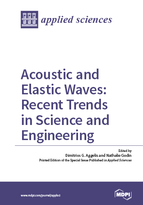Acoustic and Elastic Waves: Recent Trends in Science and Engineering
A special issue of Applied Sciences (ISSN 2076-3417). This special issue belongs to the section "Acoustics and Vibrations".
Deadline for manuscript submissions: closed (31 December 2015) | Viewed by 122552
Special Issue Editors
Interests: structural health monitoring (shm); non-destructive evaluation (nde); acoustic emission (ae); ultrasonic testing (ut); scattering; dispersion; attenuation; material evaluation; concrete
Special Issues, Collections and Topics in MDPI journals
Interests: acoustic emission; damage mechanisms; mechanical behaviour; lifetime prediction; diagnostic and prognostic; modelling of AE in composite materials
Special Issues, Collections and Topics in MDPI journals
Special Issue Information
Dear Colleagues,
The present Special Issue intends to explore new directions in the field of acoustics and ultrasonics. The interest includes, but is not limited to, the use of acoustic technology for condition monitoring of materials and structures. (The basis of this issue comes from selected papers of the 6th International Conference on Emerging Technologies in Non-destructive Testing, ETNDT6 held in Brussels May 27-29th, 2015).
Topics of interest (among others):
• Acoustic emission in materials and structures (without material limitation)
• Innovative cases of ultrasonic inspection
• Wave dispersion and waveguides
• Monitoring of innovative materials
• Seismic waves
• Vibrations, damping and noise control
• Combination of mechanical wave techniques with other types for structural health monitoring purposes.
Experimental and numerical studies are welcome.
Prof. Dr. Dimitrios G. Aggelis
Dr. Nathalie Godin
Guest Editors
Manuscript Submission Information
Manuscripts should be submitted online at www.mdpi.com by registering and logging in to this website. Once you are registered, click here to go to the submission form. Manuscripts can be submitted until the deadline. All submissions that pass pre-check are peer-reviewed. Accepted papers will be published continuously in the journal (as soon as accepted) and will be listed together on the special issue website. Research articles, review articles as well as short communications are invited. For planned papers, a title and short abstract (about 100 words) can be sent to the Editorial Office for announcement on this website.
Submitted manuscripts should not have been published previously, nor be under consideration for publication elsewhere (except conference proceedings papers). All manuscripts are thoroughly refereed through a single-blind peer-review process. A guide for authors and other relevant information for submission of manuscripts is available on the Instructions for Authors page. Applied Sciences is an international peer-reviewed open access semimonthly journal published by MDPI.
Please visit the Instructions for Authors page before submitting a manuscript. The Article Processing Charge (APC) for publication in this open access journal is 2400 CHF (Swiss Francs). Submitted papers should be well formatted and use good English. Authors may use MDPI's English editing service prior to publication or during author revisions.
Keywords
- structural health monitoring (shm)
- non-destructive evaluation (nde)
- acoustic emission (ae)
- ultrasonic testing (ut)
- scattering
- dispersion
- attenuation
- material evaluation
- vibration
- earthquakes







